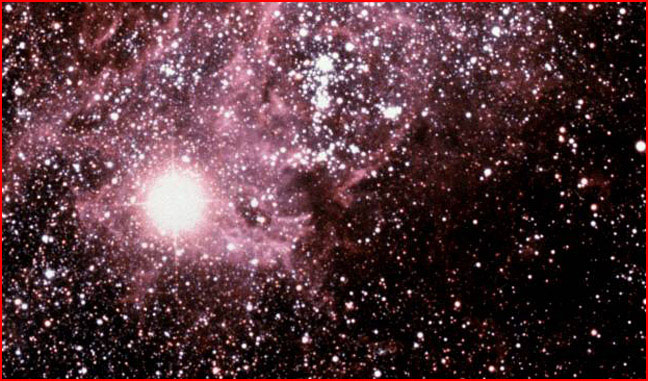
Each year, surprising discoveries raise new questions about exploding stars and other
exotic objects in space. Above: Supernova 1987a in the Large Magellanic Cloud.
Jan 30, 2007
Deep Space Explosion Baffles AstronomersA team of investigators searching for supernovae was caught by surprise recently when it observed a “mysterious object” growing explosively and inexplicably.
The event was so unprecedented that astronomers did not know how to categorize it. The object was discovered on February 22nd, 2006, and was first thought to resemble a supernova. But its brightening and its spectrum didn’t fit. Astronomers
cannot even say how far away it is, because of its redshift anomalies.According to Kyle Dawson of the Lawrence Berkeley National Laboratory in California (a member of the Supernova Cosmology Project), "It could be some galactic variable [star], a supernova or a quasar. But none of those makes any sense."
Unlike the normal supernova that takes twenty days to reach peak brightness, the mystery object brightened for at least 100 days, achieving a 200-fold increase in brightness after its first observation.
Fundamental to the enigma posed by the object is its redshift. Astronomers use redshift as a means of determining an object’s speed of recession from the observer (and from this they calculate distance). But how far away this object is remains a mystery. According to the New Scientist report, “If the strongest feature in the spectrum is a pair of calcium absorption lines, its red shift would be 0.54, corresponding to a distance of 5.5 billion light years.
“But the object is at least one magnitude brighter than a Type 1A supernova would be at that distance….And there is no sign of a host galaxy, which should be visible.”
Dawson said, “It's still going to be visible for another 2.5 months on the ground. We hope the spectrum will evolve and we see some features we can recognize."
This is yet another example of a redshift incongruity suggesting that something could be profoundly wrong in the astronomers’ assumption that redshift provides a reliable measure of distance. It is also apparent that supernovae are not as well understood as we have been led to believe. The different types of supernova explosion require different precursors and causes. And researchers have been confounded by observations of supernovae that do not live up to expectations. This latest report seems to add another misfit with theory.
Perhaps Supernova 1987a (image above) provided a clue. As reported by Wallace Thornhill, this earlier observed explosion defied expectations of astronomers while exhibiting all of the peculiar features expected of a powerful plasma "Z-pinch.” Direct observation thus suggests an electrical cause for supernovae, and the more recent deep space explosion should be examined for electrical signatures as well.
P134:3, 12:4.14 Urantia papers 1934 solves problem
Although your spectroscopic estimations of astronomic velocities are fairly reliable when applied to the starry realms belonging to your superuniverse and its associate superuniverses, such reckonings with reference to the realms of outer space are wholly unreliable. Spectral lines are displaced from the normal towards the violet by an approaching star; likewise these lines are displaced towards the red by a receding star. Many influences interpose to make it appear that the recessional velocity of the external universes increases at the rate of more than one hundred miles a second for every million light-years increase in distance. By this method of reckoning, subsequent to the perfection of more powerful telescopes, it will appear that these far-distant systems are in flight from this part of the universe at the unbelievable rate of more than thirty thousand miles a second. But this apparent speed of recession is not real; it results from numerous factors of error embracing angles of observation and other time-space distortions.
But the greatest of all such distortions arises because the vast universes of outer space in the realms next to the domains of the seven superuniverses seem to be revolving in a direction opposite to that of the grand universe. That is, these myriads of nebulae and their accompanying suns and spheres are at the present time revolving clockwise about the central creation. The seven superuniverses revolve about Paradise in a counterclockwise direction. It appears that the second outer universe of galaxies, like the seven superuniverses, revolves counterclockwise about Paradise. And the astronomic observers of Uversa think they detect evidence of revolutionary movements in a third outer belt of far-distant space which are beginning to exhibit directional tendencies of a clockwise nature. http://urantiabook.org/newbook/papers/p012.htm